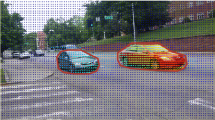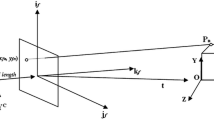Abstract
This paper presents a methodology and all procedures used to validate it, which were executed in a physics laboratory under controlled and known conditions. The validation was based on the analyses of registered data in an image sequence and the measurements acquired by high precision sensors. This methodology intended to measure the velocity of a rigid object in linear motion with the use of an image sequence acquired by commercial digital video camera. The proposed methodology does not need a stereo pair of images to calculate the object position in the 3D space: it needs only images sequence acquired for one, only one, angle view (monocular vision). To do so, these objects need to be detected while in movement, which is conducted by the application of a segmentation technique based on the temporal average values of each pixel registered in N consecutive image frames. After detecting and framing these objects, specific points belonging to the object (pixels), on the plane image (2D coordinates or space image), are automatically chosen, which are then transformed into corresponding points in the space object (3D coordinates) by the application of collinearity equations or rational functions (proposed in this work). After obtaining the coordinates of these points in the space object that are registered in the sequence of images, the distance, in meters, covered by the object in a particular time interval may be measured and, consequently, its velocity can be calculated. The system is low cost, use only a computer (architecture Intel I3), and a webcam used to acquire the images (640 × 480, 30 fps). The complexity of the algorithm is linear, fact that allows the system to operate in real time. The results of the analyses are discussed and the advantages and disadvantages of the method are presented.











Similar content being viewed by others
References
Aguilar, M.A., Aguilar, F.J., Agüera, F., Sánchez, J.A.: Geometric accuracy assessment of quickbird basic imagery using different operational approaches. Photogramm. Eng. Remote Sens. 73(12), 1321–1332 (2007)
Atkociunas, E., Blake, R., Juozapavicius, A., Kazimianec, M.: Image processing in road. Traffic Anal., Nonlinear Anal. Model. Control 10(4), 315–332 (2005)
Avidan, S., Shashua, A.: Trajectory triangulation: 3D reconstruction of moving points from a monocular image sequence. IEEE Trans. Pattern Anal. Mach. Intell. 22(4), 348–357 (2000). doi:10.1109/34.845377
Barranco, F., Tomasi, M., Diaz, J., Vanegas, M., Ros, E.: Parallel architecture for hierarchical optical flow estimation based on FPGA. IEEE Trans. Very Large Scale Integration (VLSI) Syst. 20(6), 1058–1067 (2012)
Bonneval, H.: Levés topographiques par photogrammétrie aérienne. In Photogrammétrie Générale: Tome 3, Collection scientifique de l’Institut Géographique National. Paris, France: Eyrolles Editeur 1972
Botella, G., Garcia, A., Rodriguez, M., Ros, E., Baese, U., Molina, M.: Robust bioinspired architecture for optical flow computation. IEEE Trans. Very Large Scale Integration (VLSI) Syst. 18(4), 616–629 (2010)
Botella, G., Ros, E., Rodriguez, M., Garcia, A., Romero, S.: Pre-processor for bioinspired optical flow models: a customizable hardware implementation. Proceedings of the IEEE Mediterranean Electrotechnical Conference (MELECON), Málaga, Spain, 93–96 (2006). doi:10.1109/MELCON.2006.1653044
Bruhn, A., Weickert, J., Schnörr, C.: Lucas/Kanade meets Horn/Schunck: combining local and global optic flow methods. Int. J. Comput. Vision 61(3), 211–231 (2005). doi:10.1023/B:VISI.0000045324.43199.43
Davis, J., Bobick, A.: The representation and recognition of human movement using temporal templates. IEEE Computer Soc Conf Computer Vision Pattern Recognit (CVPR’97), 928–934 (1997). doi:10.1109/CVPR.1997.609439
Davis, J., Bradiski, G.: Real-time motion template gradients using Intel CVLib. In: proceedings of the ICCV Workshop on Frame-rate Vision, 1–20 (1999)
Ghilani, C.D.: General Least Squares Method and Its Application to Curve Fitting and Coordinate Transformations, in Adjustment Computations: Spatial Data Analysis (Fifth Edition). Hoboken, NJ, USA: Wiley, Inc. (2010). doi:10.1002/9780470586266.ch22
Gupte, S., Masoud, O., Martin, R.F.K., Apanikolopoulos, N.P.: Detection and classification of vehicles. IEEE Trans. Intell. Transp. Syst. 3(1), 37–47 (2002). doi:10.1109/6979.994794
Habib, Ayman F., Morgan, Michel F.: Automatic calibration of low-cost digital cameras. Opt. Eng. 42(4), 948–955 (2003). doi:10.1117/1.1555732
Hamid, N.F.A., Ahmad, A.: Calibration of high resolution digital camera based on different photogrammetric methods. Proceedings of the 8th International Symposium of the Digital Earth (ISDE8), IOP Publishing on IOP Conf. Series. Earth Environ Sci 18, 1–6 (2014). doi:10.1088/1755-1315/18/1/012030
Kim, K., Chalidabhongse, T.H., Harwood, D., Davis, L.: Real-time foreground-background segmentation using codebook model. Real-Time Imaging 11(3), 167–256 (2005). doi:10.1016/j.rti.2004.12.004
Kraus K.: Photogrammetry Vol. 1. Fundamentals and Standard Processes (4th edition). Bonn, Germany: Ferdinand Dummlers (1993)
Li, R., Niu, X., Liu, C., Wu, B., Deshpande, S.: Impact of imaging geometry on 3d geopositioning accuracy of stereo ikonos imagery. Photogramm. Eng. & Remote Sens. 75(9), 1119–1125 (2009)
Lucas, B., Kanade, T.: An iterative image registration technique with an application to stereo vision. In: Proceedings of the Seventh International Joint Conference on Artificial Intelligence, vol.2, pp. 674–679. Vancouver (1981)
Novak, K.: Rectification of digital imagery. Photogramm. Eng. and Remote Sens. 58(3), 339–344 (1992)
Petrie, G., El Niweri, A.E.H.: The applicability of space imagery to the small scale topographic mapping of developing countries: a case study—the Sudan. ISPRS J. Photogramm. Remote Sens. 47(1), 1–42 (1992). doi:10.1016/0924-2716(92)90002-Q
Soh, J., Chun, B.T., Wang, M.: Analysis of road image sequences for vehicle counting. IEEE Trans. Intell. Transp. Syst. 1, 679–683 (1995). doi:10.1109/ICSMC.1995.537842
Toutin, T.: Review article: Geometric processing of remote sensing images: models, algorithms and methods. Int. J. Remote Sens. 25(10), 1893–1924 (2004). doi:10.1080/0143116031000101611
Tsai, R.Y.: A versatile camera calibration technique for high-accuracy 3D machine vision metrology using off-the-shelf TV cameras and lenses. IEEE J. Robot. Autom. 3(4), 323–344 (1987). doi:10.1109/JRA.1987.1087109
Weng, J., Cohen, P., Herniou, M.: Camera calibration with distortion models and accuracy evaluation. IEEE Trans. Pattern Anal. Mach. Intell. 14(10), 965–980 (1992). doi:10.1109/34.159901
Wolberg, J.: Data analysis using the method of least squares: extracting the most information from experiments. Berlin and Heidelberg GmbH & Co. KG, Germany: Springer (2005)
Wong, K.W.: Basic mathematics of photogrammetry. In: Slama, C.C. (ed.) Manual of Photogrammetry (4th edition), pp. 37–101. ASP Publishers, Falls Church (1980)
Yan, Y., Yancong, S., Zengqiang, M.: Research on vehicle speed measurement by video image based on Tsai’s two stage method. In: proceedings of the 5th International Conference on Computer Science and Education, 502–506 (2010). doi:10.1109/ICCSE.2010.5593565
Zhiwei, H., Yuanyuan, L., Xueyi, Y.: Models of vehicle speeds measurement with a single camera. Proceedings of the International Conference on Computational Intelligence and Security Workshops, 283–286 (2007). doi:10.1109/CISW.2007.4425492
Author information
Authors and Affiliations
Corresponding author
Rights and permissions
About this article
Cite this article
Filitto, D., Hasegawa, J.K., Polidório, A.M. et al. Real-time velocity measurement to linear motion of a rigid object with monocular image sequence analyses. J Real-Time Image Proc 11, 829–846 (2016). https://doi.org/10.1007/s11554-014-0472-4
Received:
Accepted:
Published:
Issue Date:
DOI: https://doi.org/10.1007/s11554-014-0472-4




